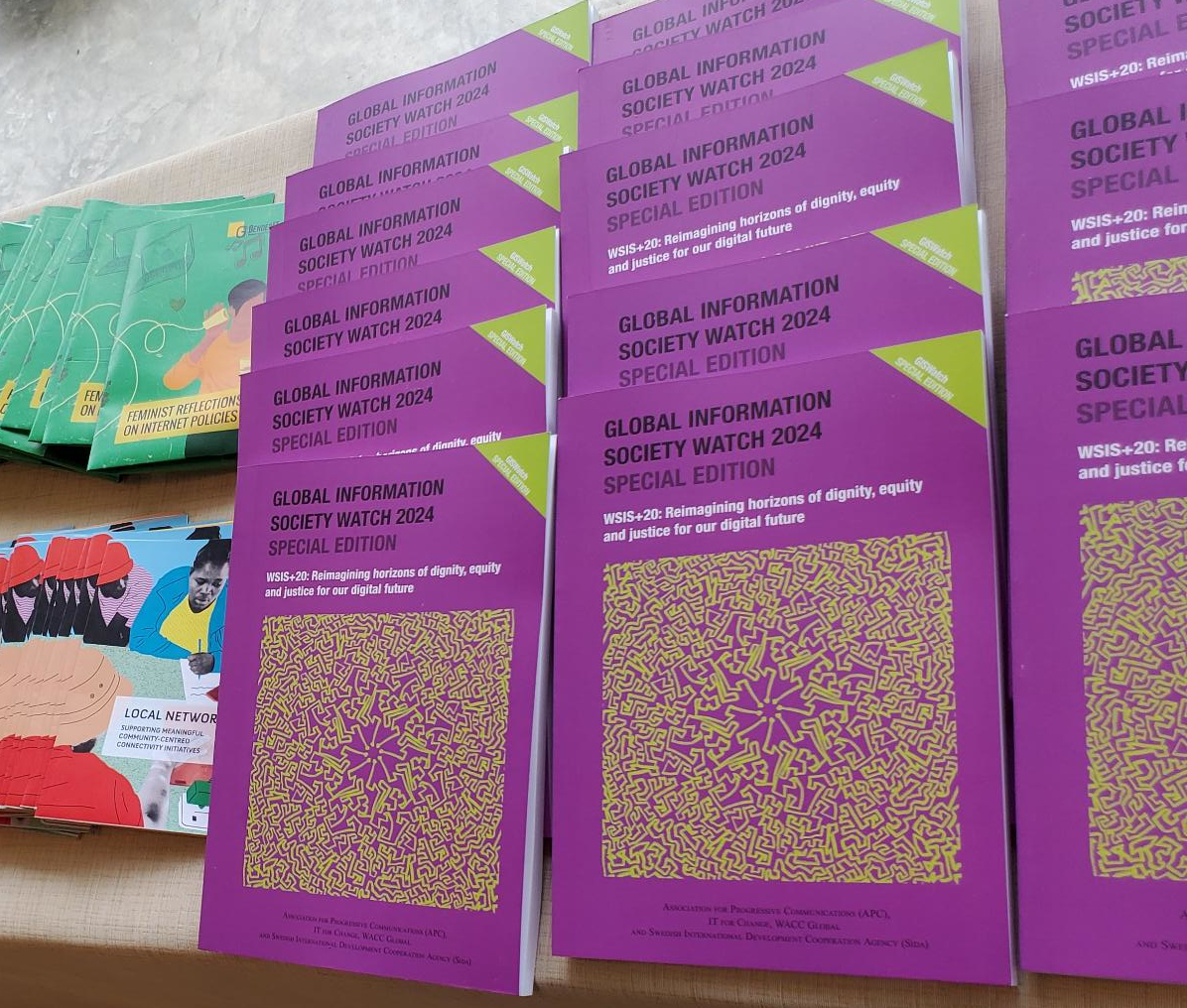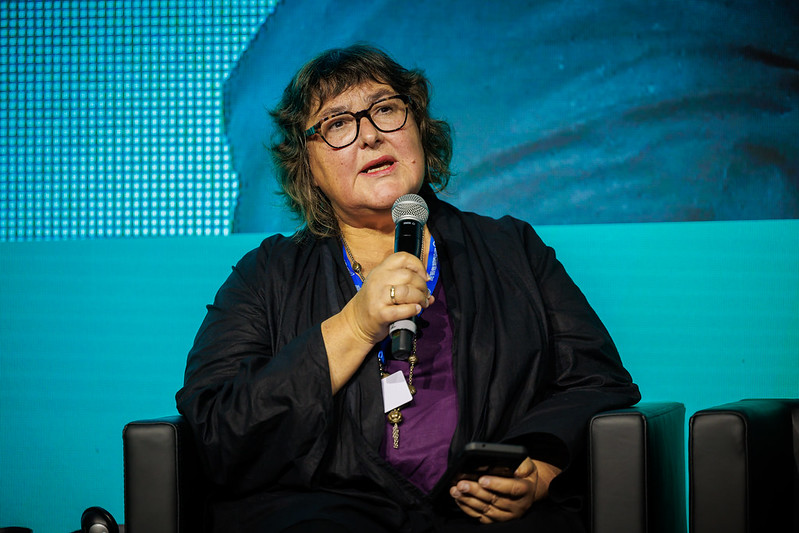
A new special edition of Global Information Society Watch (GISWatch), APC’s flagship publication, was presented in May at the APC Community Gathering in Chiang Mai, bringing together a diverse mix of attendees including past and current authors, the APC network and members of the GISWatch production team.
Shaped around the theme “WSIS+20: Reimagining horizons of dignity, equity and justice for our digital future”, this special edition was a timely opportunity to revisit the World Summit on the Information Society (WSIS) agenda as it undergoes its 20-year review. With the history of GISWatch firmly rooted in providing civil society perspectives and analysis on the evolution of information societies, including the implementation of the WSIS action agenda, it was a special moment to reflect both on the future directions of GISWatch and celebrate how it has evolved into a powerful tool for advocacy.
New horizons for WSIS+20
The content of this current special edition features 15 thematic reports from researchers and specialists around the world, some of whom engaged in the initial WSIS forum 20 years ago and have closely followed the process. This wealth of knowledge and expertise touches on important considerations, such as how the digital landscape has radically evolved in the past 20 years, leading to a shifting global terrain, new challenges and an urgent need to ensure that civil society priorities are considered in policies and decision-making processes. As one participant at the GISWatch session at the Community Gathering noted, “This edition gives us a historical understanding of how we got here, so we have the rules and arguments for how to move forward.”
Considering the complexity and ever-changing conditions shaping digital technologies governance today, this edition of GISWatch engages not only actors in the field but also key partnerships to increase its reach and amplify its impact. “This edition, produced in collaboration with WACC and IT for Change, marks an important point in relation to liaising with movements and coalitions,” said Valeria Betancourt, APC’s programmes manager who oversees the GISWatch project. “Work on the WSIS agenda is getting more complex, and GISWatch shows that we don’t have to be everywhere, but we do have to connect with those who are doing that work, in those spaces.”
Creating space for capacity building
The importance of having a space for civil society groups to work on critical themes such as freedom of expression, community networks and women’s rights (among many others) was expressed by several participants at the GISWatch session, including two APC members who have both contributed reports to numerous editions of GISWatch.
Sylvie Siyam, director of Cameroon-based APC member PROTEGE QV, recounted a story of bringing several editions of GISWatch to a meeting with the minister in charge of telecommunications, to show how the organisation had published multiple contributions. “It gave us credibility with the minister, and it’s an advocacy tool,” she reflected, highlighting how the opportunity for research and publishing strengthened their position.
Florencia Roveri from Argentina-based APC member Nodo Tau shared how GISWatch is adept at identifying emerging issues with each edition, inviting authors to think about those issues, research them and analyse them in local contexts. This also creates space for community building, ensuring that local voices and experiences are strongly represented. “When the theme is decided, we get in contact with local organisations to talk, think and analyse together,” she recounted. “For the surveillance edition, for example, we talked with expert organisations from the civil society and technology fields beyond the APC network. For the edition on economic, social and cultural rights, we worked with an anthropologist and a lawyer focusing on the rights of people in prisons. In the edition on artificial intelligence, we talked with five unions in the region about how this aspect is changing their work."
Commenting on this multi-layered process of preparing a chapter for GISWatch, Roveri noted that, "The interviews were very thought provoking for all of us. Each edition allows organisations to problematise the involvement of technology, and we learn from their expertise."

This community focus is an important component of movement building, helping organisations establish strong reputations in the field of governance and advocacy. The process of researching reports is also a precious opportunity for capacity building, as one participant noted. For some GISWatch authors, the process of researching, writing and publishing a report like this is new, and this can help them become established as a key actor in their field. As one previous author said, “GISWatch is a link between research, learning and advocacy; it’s not just about evidence-based policy. When you do research yourself, you feel more confident in your advocacy.”
Tracing history and framing a way forward
One of the core features of GISWatch that many participants agreed is unique and impactful is the collection of country and regional reports that are included in each full edition, written on the ground by authors from around the world, with a particular focus on voices from the global South. “The absence of systematic country-level follow-up mechanisms on WSIS goals – both those in the Geneva Plan of Action and the Tunis Agenda – was one of the primary inspirations for GISWatch,” said Anriette Esterhuysen during a recent interview with APC. Esterhuysen, who was APC’s executive director at the time GISWatch was first envisaged, was instrumental in the creation of the project. During the GISWatch session at the Community Gathering, she noted that the initial development of GISWatch went through numerous iterations as the team strategised how best to engage civil society in monitoring the WSIS agenda.
According to Esterhuysen, the need for direct inputs from civil society groups was an important early recommendation from long-time GISWatch editor Alan Finlay, who proposed at the outset that authors be allowed to choose their own topics as they relate to the overall theme. This was to become a central element in the production of GISWatch in the years that followed, with rich and diverse contributions from all corners of the globe giving a unique depth and breadth to the scope of each edition.
Since the first edition published in 2007, the body of research contained within the various editions of GISWatch offers an unparalleled level of context that is integral to understanding our digital evolution. As one participant remarked, “reading GISWatch is like going back and tracing history.” Another similarly remarked that “GISWatch has historical memory and a continuity of perspectives. We can read our own histories.”
This collection of historical knowledge is not only rare, but creates an important platform from which to shape informed and nuanced action steps for moving forward. Indeed, the timeliness of GISWatch allows it a remarkable level of agility and responsiveness as global currents shift. “GISWatch is useful for touching on emerging issues at critical times, like the AI and environmental editions,” one recent contributor noted at the Community Gathering. “It helps us frame a way forward.”
Looking ahead: Advocacy as a process
Immediately following the session at the APC Community Gathering, GISWatch was presented in Geneva at the WSIS+20 High-Level Event, where Anriette Esterhuysen and Valeria Betancourt put forward a set of key messages from APC calling for the support of meaningful engagement from civil society. The statement stipulates that “civil society has a key role to play not only in community-based initiatives to empower people to acquire the necessary skills to use, understand and contribute to the development of technological advances, but also in creating awareness, building capacity, and most importantly, asserting and upholding the rights of the marginalised.”

The presentation of the current special edition of GISWatch, which examines this critical need for civil society engagement, is an important opportunity as we approach the WSIS+20 milestone. As an advocacy instrument, it will continue to pursue the following objectives:
- For governments to take into account civil society perspectives on our digital future, as part of the configuration of the future of WSIS.
- To influence key decision-making processes, including modalities, substantive scope and outcomes of the WSIS+20 Review process.
The various chapters in this report will continue to be a reference as APC continues to develop its strategy for engagement with the WSIS+20 review, and will also be central to APC’s participation at the global Internet Governance Forum (IGF) at the end of the year.
Beyond the special edition of 2024, GISWatch is evolving as a powerful advocacy tool that accompanies the implementation of APC's strategic plan through the production and consolidation of analysis and research, the exploration of emerging issues, and the delineation of advocacy paths and strategies at different levels.
Click here to download a copy of the current special edition of GISWatch.
To follow APC’s engagement in the WSIS+20 review, sign up for the APC Newsletter.